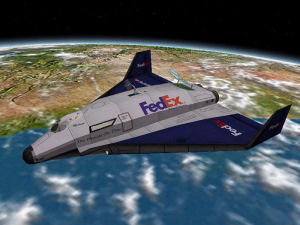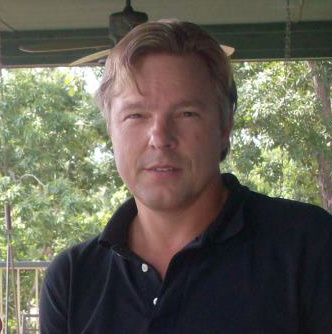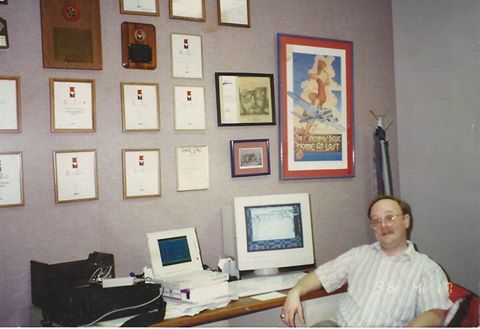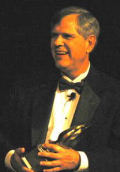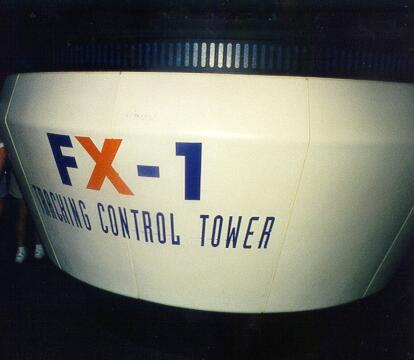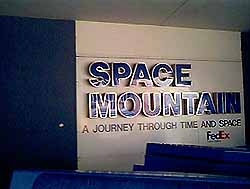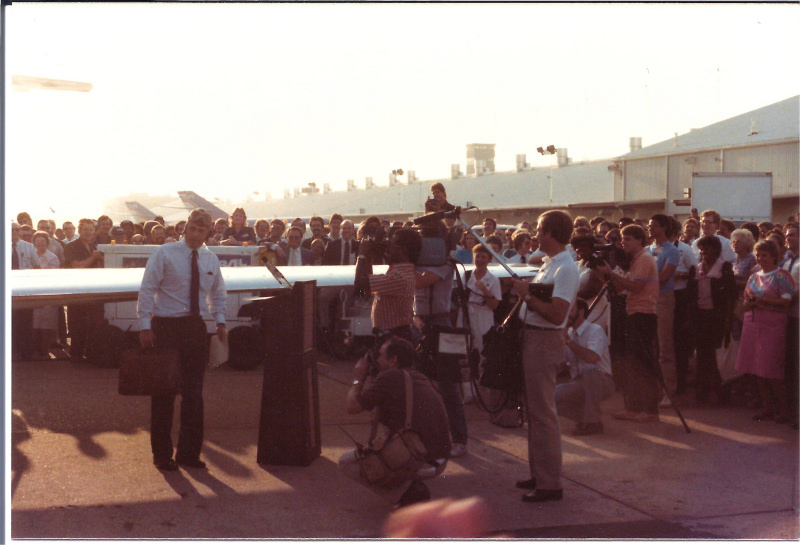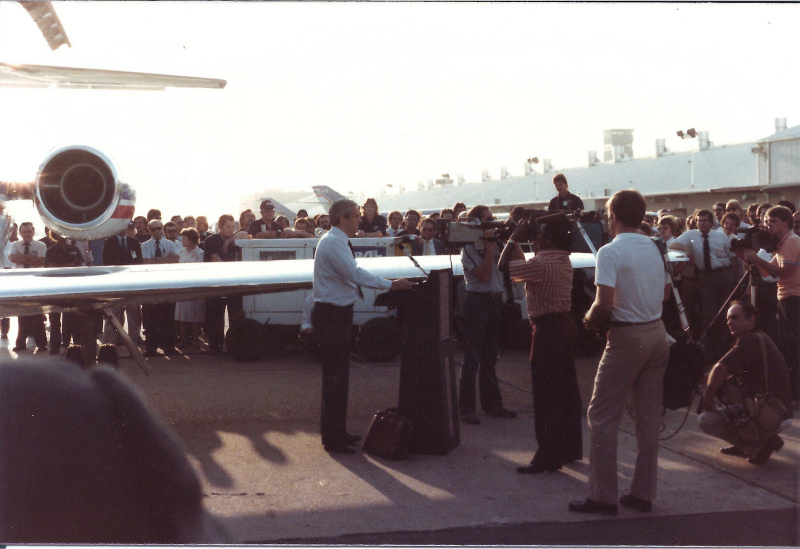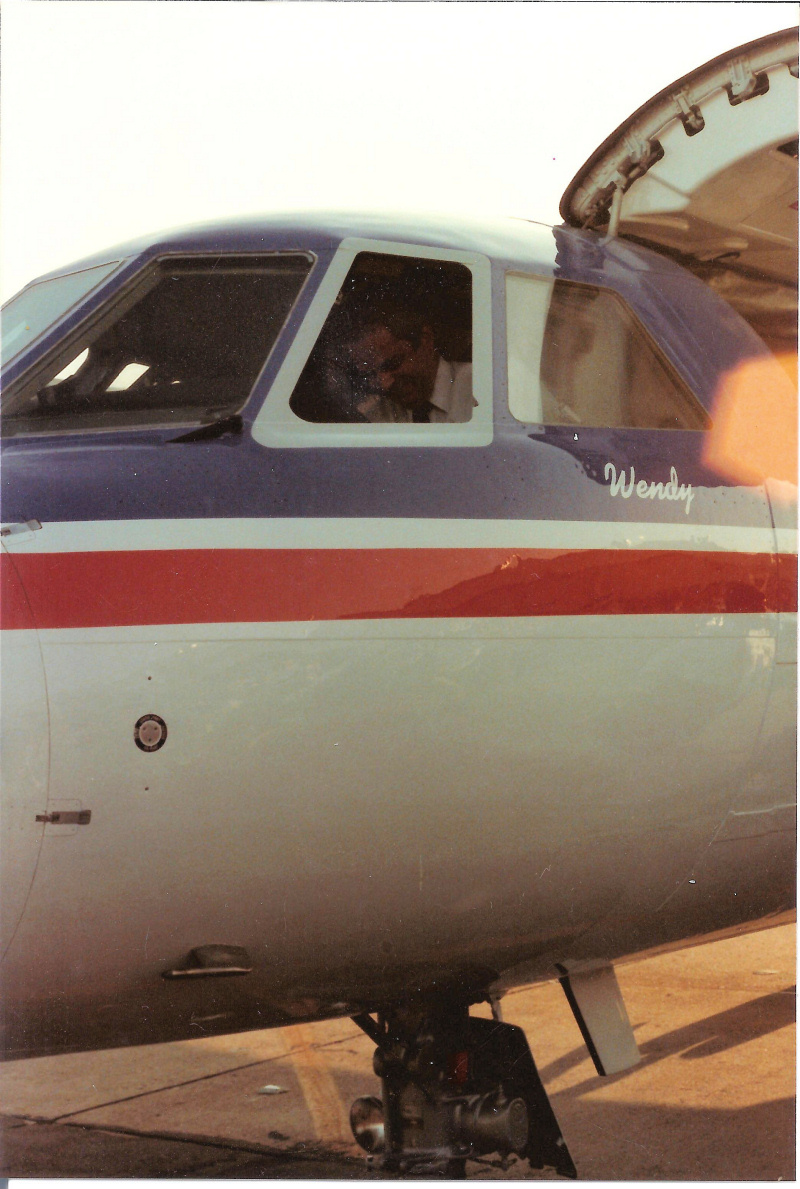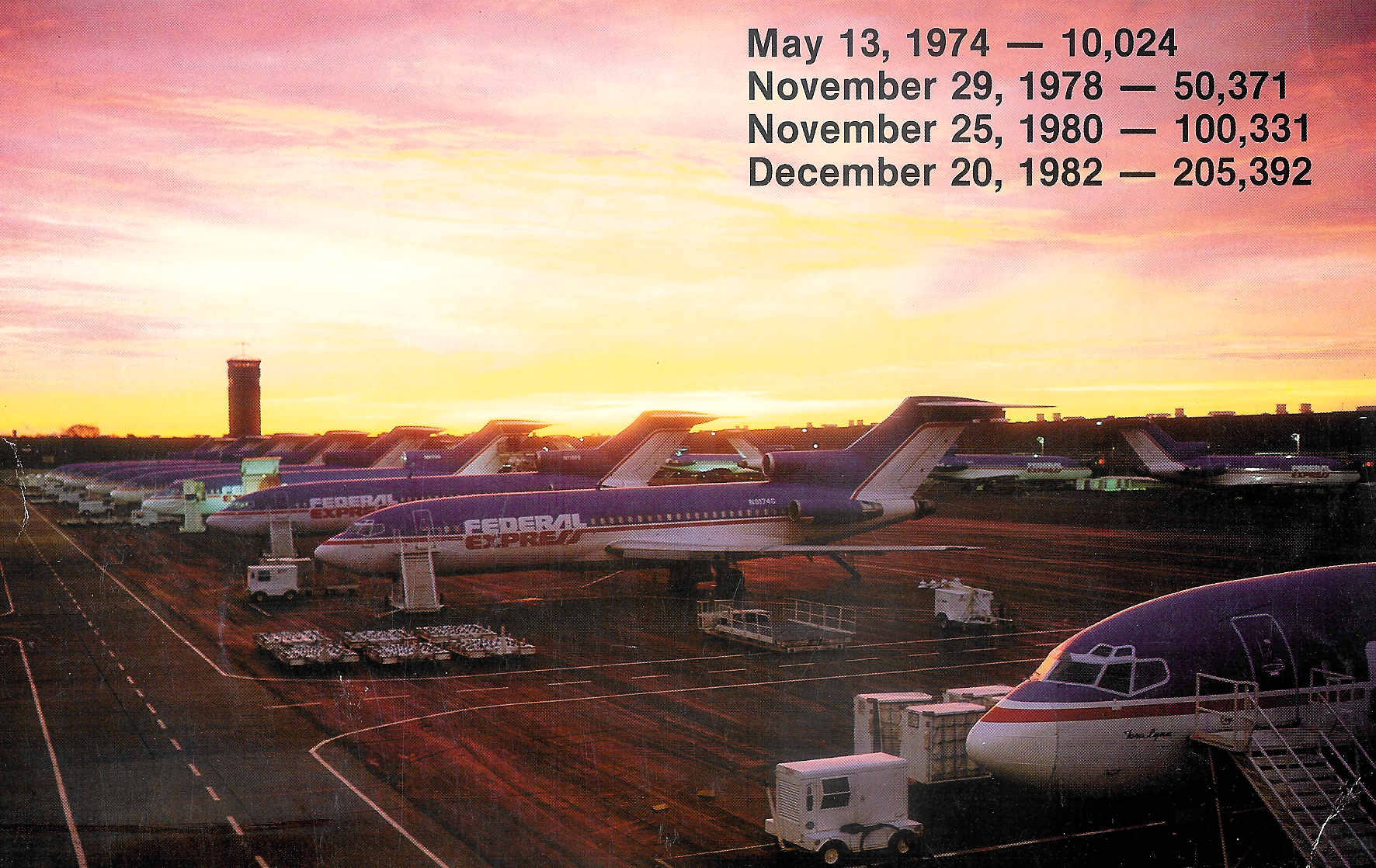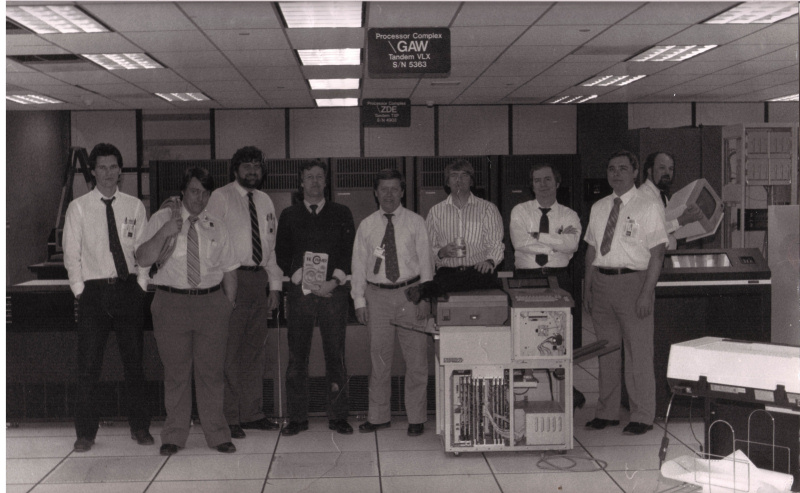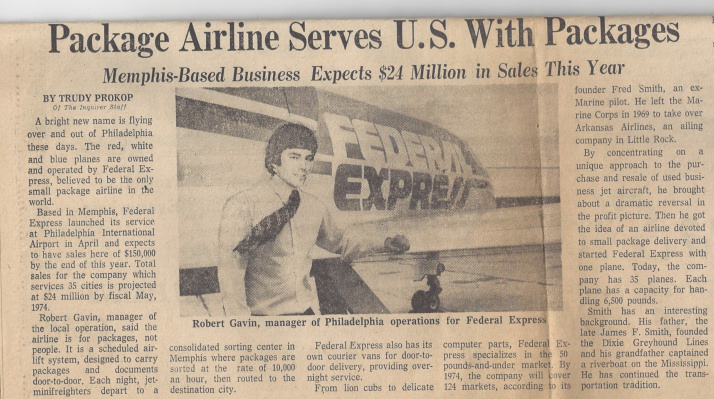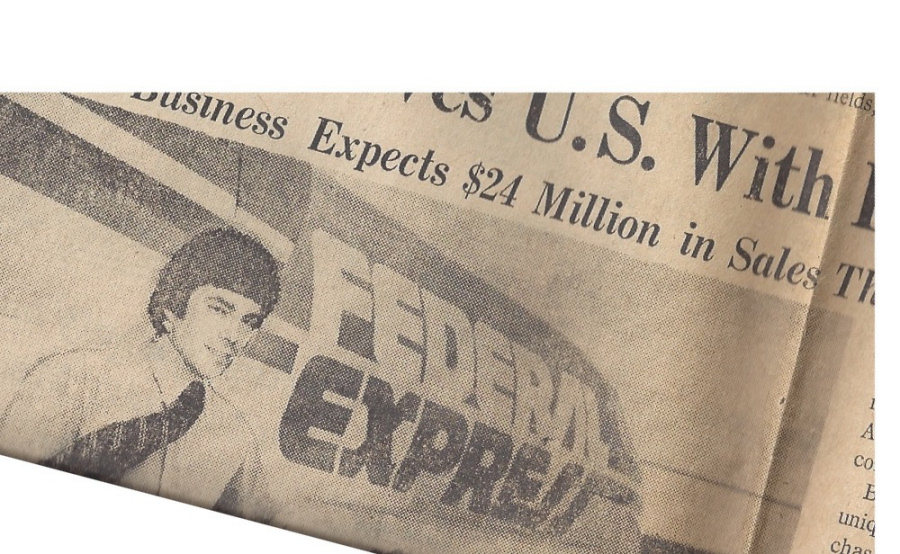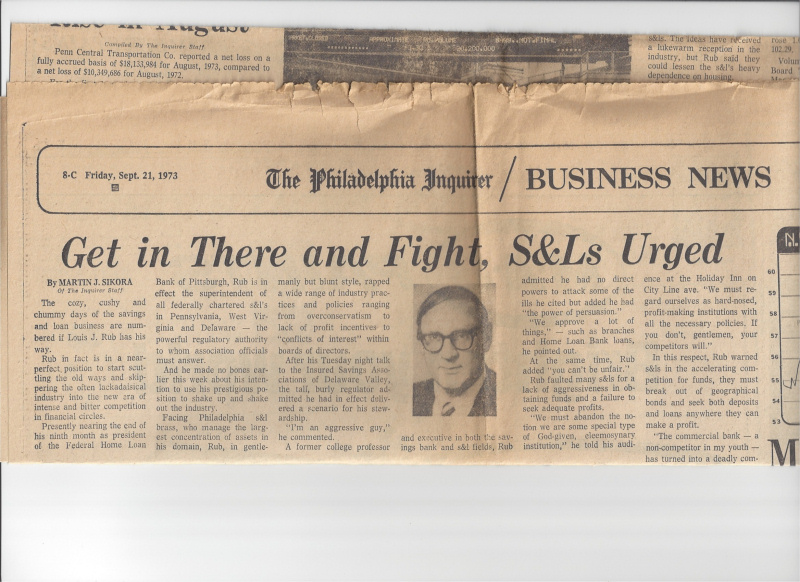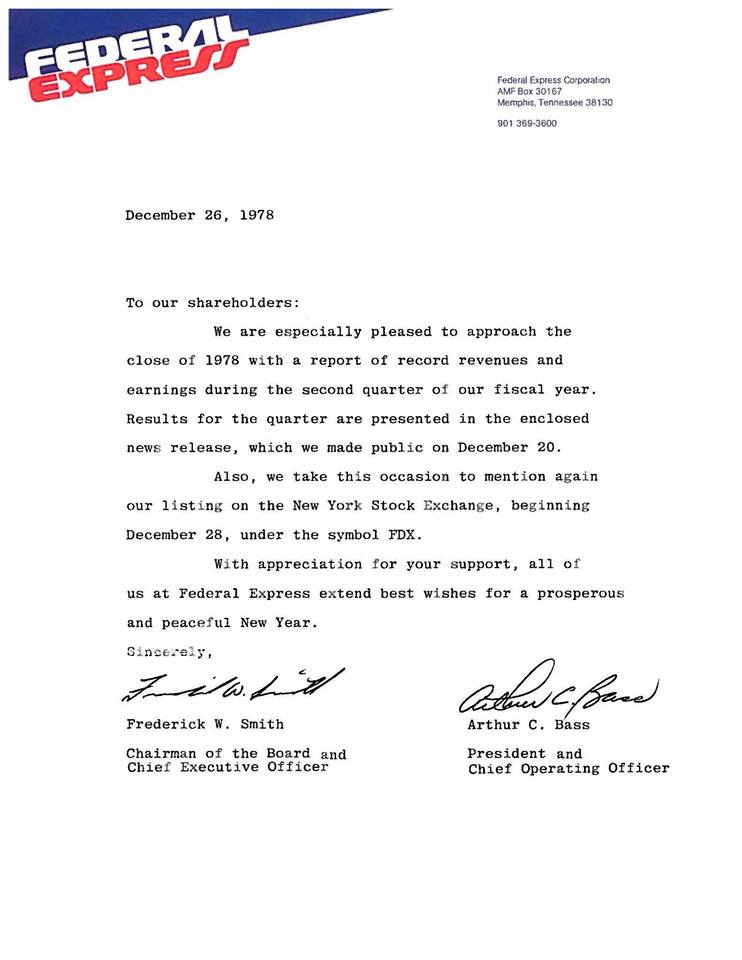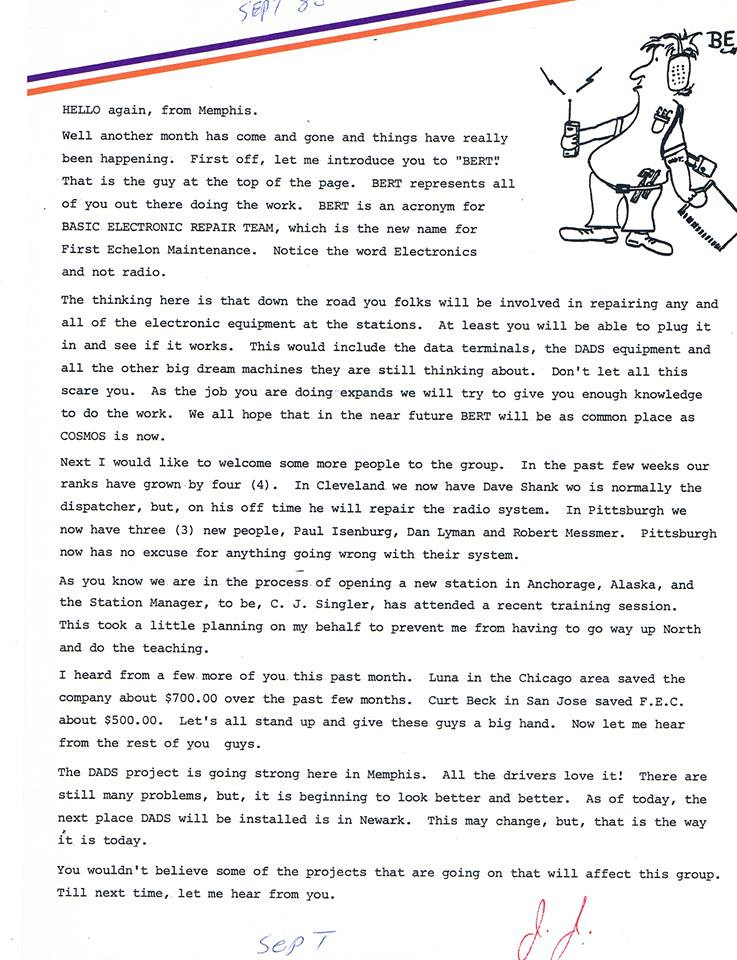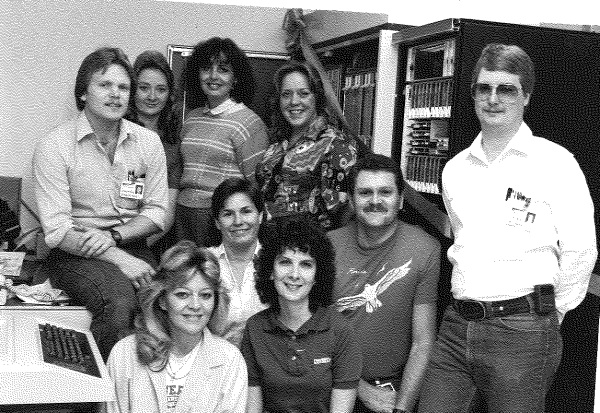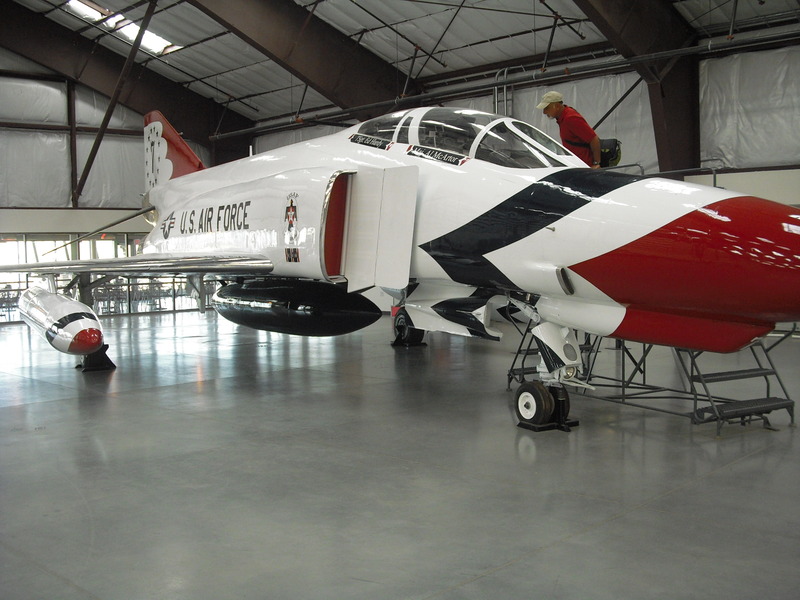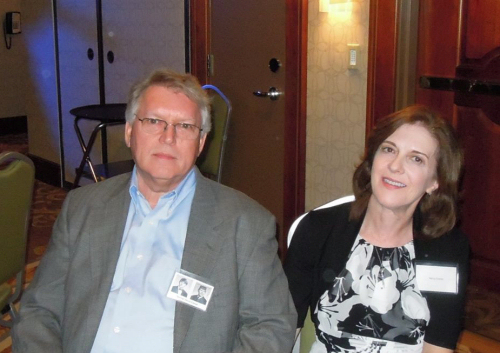Some memories of the early 1980's
I arrived at FedEx around Feb 2, 1980. I was about the 14,709th employ hired. I think Randy Roy was hired a few days later. I was hired as a Senior Engineer in the Telecommunications department.
FedEx in 1980
At that time there were around 10,000 couriers in the fleet, and FedEx was flying Falcons and 727's.
I believe there were only one or two services. You could get delivery by noon primarily.
Overnight Letter/Paks
In 1980 Overnight Letter was added and later, and later, delivery by 10:30 was added as a service.
I remember discussions on the Overnight Letter. Some were for it, some against it. But FWS was for it, so it went forward. Some of the objections were the low price charged, versus cost to pick up & deliver it. The first scenario was that we would only pickup Overnight letters if there were other packages to pick up, otherwise there would be a pickup charge.
A short OL story
I was a Sr. Technical advisor and around 1984. Antony Kong & me were called into a meeting of VP's, SVP's, Directors, Fred Smith and with Jim Barksdale on the phone, from a conference. They were discussing a project and several were not being supportive of the direction where FWS was leading the group. I was brought in for technical support if a question arose. A certain Director started pontificating why we should go in the opposite direction from FWS' proposal. Mr. Smith didn't want to hear it...so what he did is look up at the ceiling and proclaimed in a loud tone, to the ceiling or whomever "O YE WHO Were AGAINST..... THE OVERNIGHT LETTER........" that froze the Director, who then bowed his head and said nothing else.............and Mr. Smith proceeded. Fortunately it was 7pm on Friday, and a few minutes later, FWS then turned to me and Antony, and said "MR Burk, MR Kong, I am about to say things that are going to be very intense to this management group, that you do not need to hear. You are Excused, Enjoy your weekend....." and we left immediately....
Volumes rapidly grew for OL and Courier paks, but these had to be sorted by hand, with handlers memorizing many zip code combinations. Later a prototype project was developed called D03 which used video cameras to capture moving courier paks and OL's, sending the image to keyers to type in the zip code. Diverters would then push the products into bags for those zip codes. The prime contractor went bankrupt before full implementation. Later the Small System Support and projects like Purple Lights would automate sortation of these products while weighing them at the same time.
A short time later, HotelPak was added, which placed envelopes and airbills at hotels for travellers, but this wasn't as much a success.
Clark Tower
My office was on the 17th floor of Clark Tower and I got a window looking towards the south. Later on that year, the first DC-10 arrived and they announced that it would be passing by Clark Tower around 3pm. I had a good view of the very first wide-body aircraft painted in the purple & orange colors.
Data Systems, as Info Systems was known then, had around 230 employees. About 60 of those were in Colorado Springs. The Telecommunications department was probably less than 30 employees and the director was Larry Lake, who reported to Jim Barksdale.
The Network Control group was also on the 17th floor. I think the supervisor was Ray Peek. The IBM computers were also at Clark Tower.
As I came into FedEx, I felt part of a growing and thriving company. COSMOS had been launched, Call Centers were being consolidated into the large cities versus having the customers call the local offices.
On the horizon in the next year 1-2 years would be the launch of the DADS/Radio System, the first automation device, COSMOS IIa scanning and tracking of packages, the SuperHub and much more.
There were still politics and people pushing for promotions, money for their projects and jockeying for visibility; but the company was growing and there would be many new opportunities for growth.
It seemed the company did put focus on People. Couriers were given their due as our frontline contact with our customers.
Merits
In those days, for a while, you could get a merit every 6 months, if you were under the midpoint of your salary. Fortunately I was brought into the company at about $10 under midpoint to allow me to get my first merit in six months. And I think the merits were up to 10% of salary, so you could rapidly get to your midpoint.
I was immediately assigned to work on the DADS project and for the next 6 months, I probably put in 60-80 hours a week, counting my work at home. It was an enjoyable project primarily because I had freedom to do whatever I needed to get the job done,
and I was doing things never before developed in the industry.
New Merit System
About the next year, the company decided to change the merit system, which had allowed you up to 20% a year. They went to merits that were around 3% twice a year if under midpoint, or 3% a year if you were over. But they also implemented a cost of living merit...each quarter.
Inflation ran very high in the early Reagan years with interest rates for homes going to 20%. My brother in law who works at FedEx bought his first home, with an 18% mortgage.
Inflation ran 3% a quarter. If you were under midpoint your merit could be up to 18%.
(3% cost of living per quarter and 3% merit twice a year)
This didn't last but a year and the entire cost of living raise was factored out.
Air Traffic Controller Strike
In Aug 1981, over 13,000 of the 17,000+ air traffic controllers went on strike, which was illegal to do. President Reagan warned that he would fire those that went on strike.
Air traffic was shut down, for a day, and the government brought in as many of the military air traffic controllers that they could to work with the 4,000 civilian controllers.
Pres. Reagan then fired the air traffic controllers and a new system was put in place.
No flying at night. There could only be one aircraft in a lane at a time, and no other aircraft could fly at that elevation in that lane, until the first plane landed.
This would effectively have shut down Federal Express.
With some quick politicing, Federal Express was then allowed to fly at night and the business wasn't affected. But this had a lot of us worried.
The SuperHub
The SuperHub was a major accomplishment, just to get it built. All packages were previously sorted by hand on a circular belt by employees looking for their zip codes. The SuperHub would automate much of this process and greatly increase capacity. In addition, versus manually unloading the aircraft, the larger 727's could just pull up to the dock and unload/load from there.
The effort was led by Mike Basch with hordes of other employees. Since some government bond monies were involved, there were strict policies to ensure proper bidding etc. The Austin Company was the prime contractor and I remember anything they purchased for you, you had to add 10%, even for chairs.
I was assigned by Jim Barksdale to go figure out why the SuperHub was mis-sorting around 90% of the packages as they initially tested the system.
Before my first visit to the SuperHub, I had misplaced my badge, and it was going to take 1-2 weeks to get another one. I knew I couldn't get into the SuperHub without a badge. I went to the Place of Badges and asked for one in 30 minutes. They said no way. I then told them I would call Jim Barksdale and have him call them immediately, if they couldn't do this...because I was doing as he asked......they decided that wouldn't be necessary, I got the badge in 15 minutes.
I was looked on with suspicion at first, being from Info Systems, but they adapted to me, and we were able to figure out the issues and get sortation to 100% accuracy.
I worked at the SuperHub for a couple weeks from 10pm to about 6pm, got some sleep and then went to my day job. Somehow for many of us, adrenalin kicked in, the job was important and you wanted to do what was needed to make the company successful.
The follow up was interesting. The SuperHub group hired their own Computer Consultant as a defensive measure to ensure that the Info Systems group wouldn't tell them what to do. So instead of me telling them what to do, I told the Consultant, who then told them, and they then enacted what I had originally put in a memo for them to do.
Eventually, Info Systems did hire some personnel to work with the SuperHub group, and the SuperHub even hired some of the IT people into Hub Systems to keep their issues in focus.
So, there were some politics, but to be honest, Data Systems didn't have much expertise in the minicomputer/microcomputer arena at the time. There was really only 1 person in Memphis(me) and one in Colorado Springs(Joe Williams) who had both hardware and software expertise in microcomputer systems at that time. The other Info Systems employees were either Telecommunications or Cobol programmers and support staff.
Over the next couple years they hired probably a dozen people with small systems experience into the Telematics group & Hub groups.
I got so familiar with the SuperHub that I would give tours of major vendors for the next several years....until they filled in the creek and expanded over it. I was lost in the SuperHub after that and then had to depend on guys like Chuck Sertich, Jim Bentley or Alex Vergos to get me around it.
Terminals
Most computer terminals were IBM 3270, or 3270 software running on Honeywell Incoterm computers. There were also some Western Union Teletype 3270's.
When FedEx was going thru tough times, many vendors supported the company as they struggled to meet commitments, some waiting many months before receiving payments. Honeywell was one of those companies. The initial computers ran a kind of teletype texting line by line messaging format and protocol.
IBM ran a smart screen form type format with BiSync or SDLC/SNA protocols. When FedEx switched to IBM, they were going to buy 3270 terminals to use in the call centers. Honeywell asked to be given a chance to provide these terminals and their controllers were changed to support IBM.
So you want Word Processing?
Remember there were NO PC's in 1980. There were some minicomputers with terminals such as DataGeneral & Digital Equipment and also some hobby type microcomputers such as Apple, Kaypro, Altair. Some smaller companies cropped up putting typewriter and word processing on their systems.
Wang was a dominate player but very expensive costing $2000 for a terminal plus you had to purchase a $30K mini computer. There were a few Wangs in the company and everyone was asking for word processing. Another feature of the Wang was that it could also be used as a 3270 terminal and access COSMOS and other IMS programs.
Jim Barksdale didn't initially want to pay that much for the demand, and a smaller company proposed that they adapt their word processing computer and put 3270 on it.
This company was called Jaquard and their word processing was good & cheaper.
After development, Jaquard brought in their new system. It was supposed to support 32 3270 terminals,, but could only support 1 3270 session with response times around 30 seconds. Normal response times to access the IBM ran 2-5 seconds on a normal 3270 device.
So, Jaquard was out, and everyone started purchasing Wangs.
New DADS computer IBM?
After DADS was rolled out in Chicago to support hundreds of terminals in the courier vans, Jim Barksdale sent a request to me to see if we could use IBM's mini computer instead of the DEC computer. He was not high on DEC, and was very high IBM. One benefit of using IBM is that 3270 terminal support was built in, so dispatchers could access COSMOS directly.
The original DEC system ran about $44,000 with 4 ISC color terminals.
(In later years, between Jim Moore & Jim Bentley's bartering skills and looking at newer options this price would eventually be cut in half.)
I looked at the Series/1 and got some volume pricing. The similar system that would meet our needs clocked in at $130K per system. Prices were still high in those days.
So, IBM was out,,,, DEC was in. About 15 years later, these systems would be replaced by HP Unix minicomputers at about $8K each, and then use Personal computers as terminals. Winn Stephenson had used his negotiating skills to get the Unix systems at 1/2 price.
So, you want to be a Manager?
I had been a manager at Data Communications Corp before coming to FedEx so I had about 2 years managerial experience.
I took a job at FedEx to expand my technical expertise in programming and to do something new. Ancel had proposed initially working on DADS for Jim Moore, and possibly then programming a new Comten front end (to the mainframe) that he had proposed. That project wasn't approved.
Around 1982-83, my new Director decided I needed to become a manager. I didn't want to become a manager, but he put me into a new process for managers anyway.
You had to fill out a 30 page Standard Resume, giving examples on your leadership, projects, and style. This was to be followed by a panel interview from the Directors.
I did the Standard Resume, and went on vacation. My director called me on vacation and told me a slot had opened up and he wanted me to come in immediately and interview. So, hesitantly I did. The panel was about 10 directors and VP's. I remember Hank Howell & Jim Tollefson among them. I was asked questions for 2-3 hours and thought I did ok. I later found out that I came in second of all the interviewees. Randy Roy was first, I believe.
A few months later, my group received approval to hire 26 new developers based on the work that David Ewing and I had done for the Hub. The director told me, he was going to make me a manager and give me 8 of the people to do the 30 projects...and he was going to do something else with the other 18 postings.
There was a disagreement, I didn't want to be a manager at the time, but he decided he was going to do the paperwork and make me a manager. He said it would be good for me.
Anyway I politely disagreed, called Ron Ponder, who immediately promoted me, and transferred me into his group.
Other Management Techniques
How to become a manager was changed several times thru the 80's as the company fine tuned the process.
One Personnel group came in and decided you needed a Masters degree to be anything.
Another group later came in and decided you needed Psychological profile testing, even if you wanted to be promoted. And yet another group came in and you needed classes, work exercises, management skills and a panel interview...which was graded solely on whether you answered 2-8 points for each question.
In the 90's general type requirements was put into a standard LEAP process and interviews done by the group hiring the position.
These are just a few of my memories the first few years. I was busy, proud and content with my work and all the contacts I made at the company.
I was especially proud of working for FWS and Jim Barksdale, and later Ron Ponder.
Each of them treated me very well and gave me many opportunities. |
